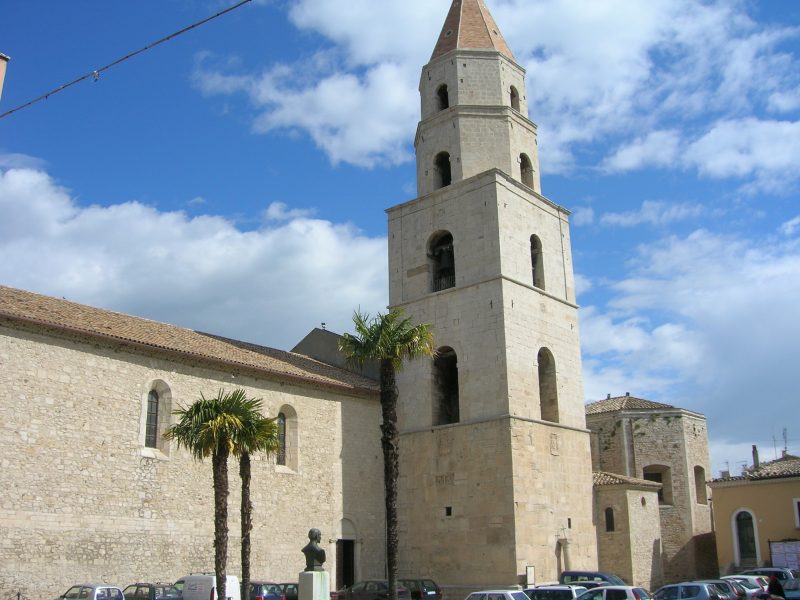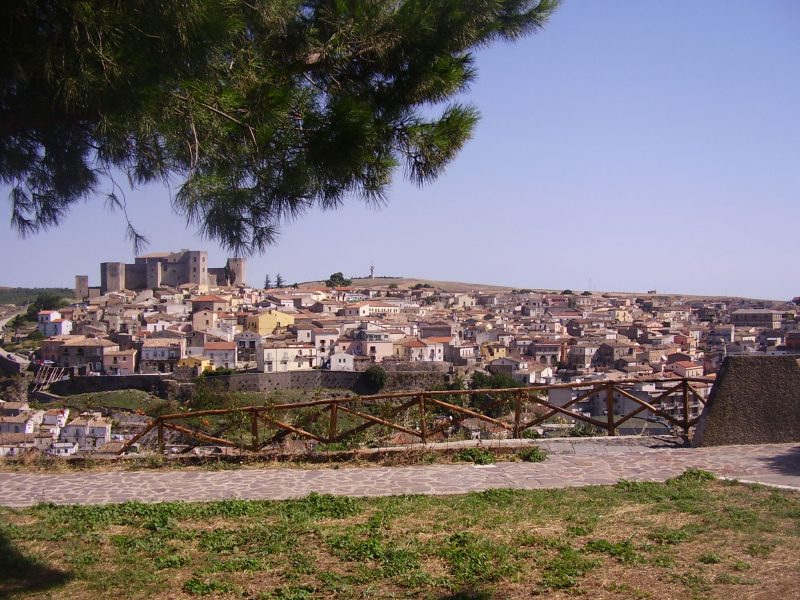The Borgo of Castelmezzano
Castelmezzano is a small and charming borgo, with the unique magic that only small mountain villages have.
Its houses of soft, pastel colors are follow the lines of the rocky ridge of the mountain they are clustered on. The Dolomite mountains of Basilicata protect this little village from the rush of traffic and the chaotic noise of city life.
Piazza Antonio Conte Campagna is the little piazza of this borgo, perched like a balcony overlooking the valley of unspoiled nature, and offers a wonderful view of the town.
Castelmezzano is the ideal place for people looking for peace and quiet and pure mountain air, and also for sports lovers and climbers: from its ancient streets you can reach the hiking trail of Via Ferrate of Salem, or stop just before to do some climbing on the equipped walls, where you will have a full view of the Flight of the Angel, which will inevitably want to experience!This borgo is a magical place, inhabited by people who always ready to meet you with a smile and a greeting.
To truly know Castelmezzano, and even a little about Basilicata, you need to stop and taste on of Lucio’s sandwiches, made with artisan cured meats from Pollino, premium artisan cheeses, prepared with condiments, creams and jams that enhance every flavor. As you let yourself be transported by these mouth-watering delicacies, Lucio will tell you the history of these mountains, of the Knights of Templar that passed through the town, and all the interesting details and peculiarities of Castelmezzano. It would be difficult find someone else with eyes so full of passion and love for their native land.
Castelmezzano is a peaceful borgo set 830 meters above sea level in the heart of the Dolomite mountains of Basilicata.
Castelmezzano’s origins date back to the fifth and sixth century B.C., when a group of colonists from Ancient Greece reached these mountains and founded Manuoro (hand of gold). This little village continued to develop and grow until the tenth century, when the continual invasions by the Ottoman Saraceni forced the inhabitants to leave the town. Legend has it that one of these exiles, Paolino, found the ideal place to build their new village. It was in a perfect location, set over steep and rocky cliffs, so that in case of invasion, massive rocks could be rolled down the cliffs to crush oncoming invaders.
The arrival of the Normans in the eleventh century brought centuries of peace and development to the community. The Normans constructed a fortress at the peak of the highest point, and you can still see the ruins of the wall and the stairway leading to the summit. The name of this ancient fortress, Castrum Medium, lent its name to the borgo:Castelmezzano, defined “di mezzo”, in the middle, because it is located between Brindisi di Montagna and Pietrapertosa.
The arrival of the Angevins marked the beginning of a period of decline for Castelmezzano. The next dominating rulers were the Aragons, arriving on the wave of feudalism, a period when the borgo passed from one noble family to the other, with no improvement to the socio-economic conditions of the community.
During the period of the unification of Italy, Castelmezzano experienced the phenomena of the “briganti” (rebels against the ruling class), because the caves in the cliffs and the thick vegetation offered perfect hideaways for the ‘briganti’. The period after the unification of Italy brought on an economic crisis, driving many families to emigrate to America in search of a better life.
The ancient streets and magnificent mountains of Castelmezzano provide everything you could need to live in peace and tranquility. In 2007, the American publication, ‘Budget Travel’, included Castelmezzano in the list of the ten most beautiful unknown locations. The borgo was listed together with Asian, Middle-eastern and French regions.
For some years now, Castemezzano has become a popular national and international tourist destination, partially because of the breathtaking “Volo dell’Angelo” (Flight of the Angel) which connects the borgo via suspended cable to the nearby mountain village of Pietrapertosa.
Chiesa della Madonna dell’Olmo
The parish Church of the Madonna dell’Olmo dates back to the 13th century. It was built near an elm and a water source, both symbols of a mystical spirituality and legends linked to the Holy Grail.
The church is in Romanesque style, which over the centuries has undergone various remodeling interventions. The external façade is square, divided by four columns and four large windows. Along the upper cornice there are bas-reliefs depicting flowers, two headed eagles and bulls’ heads. This motif is interrupted at the center by the presence of a clock, and under it, a niche with the statue of San Rocco, protector of the village.
The interior is characterized by a dazzling brightness, with a single nave and side chapels. Of great artistic importance are the two paintings by Girolamo Bresciano, the “Madonna delle Grazie e due Santi Domenicani” and the “Sacra Famiglia”, dating back to the 17th century. A central niche houses a statue of the Madonna and Child, known by all as the “Madonna dell’Olmo”.
The Belvedere and the Ruins of the Norman Fortress
The main road of Castelmezzano is long and winding, intersecting with uphill lanes and ancient stone stairways. At a certain point the street narrows, giving precedence to nature and the small houses along it, making it impossible to go further by car. Continuing on foot, you can admire the small Baronal Palace of Castelezzano, distinguished by the emblem of the municipality.
Despite what you might think, the road is not tiring to walk, and in a moment you reach the other side of the village, where you find signs indicating the Belvedere, and how can you resist going up?
Leaving the borgo behind, you climb the wide steps, with the scent of Mediterranean foliage filling the air, flowers peeking from the rocky ridge and informational placards along the way which recount the history of the mountains, the flowers and the land.
The last stretch leading to the panoramic balcony of the Belvedere is a bit more arduous, but once you arrive, there is refreshment for your mind and your soul. You will find yourself before a view that goes beyond the imagination, overlooking the woods, the mountains, and the streets of the historical center, where you can glimpse the women collecting fresh herbs for soup, the elderly chatting on their stoops, and the children chasing each other through the stone lanes and little squares.
Behind the railing of the Belvedere are the walls marking the ruins of the Norman fortress and a high peak, with a staircase carved into the rock. The more adventurous, with a qualified guide and the right equipment, can choose to climb the mountain, reaching the summit.
Slightly lower than the Belvedere, chairs have been set up, and every Saturday, a light show of projections on the rocks creates a magical and evocative atmosphere that should be not be missed.
The Gallipoli Cognato Park and the Piccole Dolomiti of Basilicata
More than twenty seven thousand acres of virgin wilderness: this is the Gallipoli Cognato Park and the Piccole Dolomite of Basilicata. Whether you are an experienced hiker, or simply want to enjoy a walk through the woods, this marvelous park has something for you.
The park offers a vast choice of hiking paths and recreational and educational activities to participate in, beginning from the town of Accetura and continuing on to other villages like Pietrapertosa and Castelmezzano.
The park crosses through the forest of Brindisi Cognato and the Montepiano Forest, where you can find oaks, holm oaks, and also ash trees lining the streams and the seasonal bodies of water. Sandstone rocks guard the ruins of ancient fortifications that now offer shelter to wild boars, foxes and wolves. This is surely a park worth visiting, perhaps in search of the extremely rare species of “Tritone italic” and “Salamander with glasses”, which have been spotted along the paths of the park.
Castelmezzano and the Knights of Templar
At the entrance of Castelmezzano, you can see a flag that stands on a mountain top, a flag with the symbol of the Knights of Templar. Just stop to ask for information and you will be catapulted into a thousand-year-old history, interwoven with an ancient spirituality poised between legend and Christianity.
It is said that thousands of years ago, the Knights of Templar passed through Castelmezzano and left a small picture of the Madonna della Luce, a wooden statuette of the Madonna with Child, and a thorn from Christ’s cross, which was lost and never found again.
The Church of the Madonna dell’Olmo still safeguards the two gifts left by the Knights: entering on the left you can admire a golden Baroque altar, inside of which is the small picture of the Madonna, with engravings in Latin. To better admire it, a larger reproduction has been placed beside the altar. On the left side of the entrance is the wooden statue of Our Lady, far from the classic portrayals we are accustomed to, and much simpler in appearance.
The Knights of Templars left other traces of their passage. Just climb the steps behind the Church of the Madonna dell’Olmo to see the Templar Cross, engraved in the walls. And the very emblem of the city recalls the presence of the Templars, with a design of a shield upon which are two Knights of Templar in traditional garb, astride a horse.
The Vie Ferrate, the Nepalese Bridge and the Flight of the Angel
The Vie Ferrate are equipped hiking trails for fairly experienced hikers and climbers, which will lead you on a discovery of the Dolomites of Basilicata. There are two trails, the Via Ferrata of Salem, which is 1,731 meters long and leads through the rocky cliffs of Castelmezzano, passing the ruins of the Norman fortress, and the Via Ferrata of Marcinosa, located in Pietrapertosa.
The two Vie Ferrate have recently been connected by a Nepalese Bridge, seventy-two meters long which passes over the Camperino river at a height of 35 meters off the ground. The bridge can be crossed with the appropriate equipment and with the assistance of a guide, for beginners.
Starting from Castelmezzano, follow a stretch of the Via Ferrata, passing through the “Antro delle Streghe” (the Witches’ Cave), and you reach the entrance to the bridge, which will take you to Pietrapertosa, and continues with the Via Ferrata.
The Nepalese Bridge is not the only means connecting the two villages. If you are seeking a jolt of pure adrenaline, and a one-of-a-kind experience to recount to family and friends, you won’t be able to resist the adventure of a lifetime: the Flight of the Angel. Strapped in securely to a steel cable, you start at the top of the mountain and glide across the entire valley. It feels like you are flying, soaring over the wilderness that rushes by below you.
There are two lines you can take, either individually or in pairs. You can choose to descend from Pietrapertosa with the San Martino line, that starts at a height of 1,020 meters and goes down to Castelmezzano at as height of 859 meters, or you can invert and choose to launch off from Castelmezzano from a peak at 1,019 meters that descends to Peschiera arriving at the borgo at an altitude of 888 meters over sea level, flying along a distance of 1,452 meters. Whichever you choose, it will be an experience you will never forget.
”Vito Danced with Witches” and the Legend of the Path of the Seven Stones.
Basilicata is a land of legends and mysteries, and in Castelmezzano one such legend can be found along the “ Sentiero delle Sette Pietre”, the Path of the Seven Stones, which is the ancient road connecting the borgo to neighboring Pietrapertosa.
The Path of the Seven Stones is a sensorial trail leading through a thick forest, until you suddenly reach seven monoliths, similar to “Dolmens”. These stones represent an encounter with the mashare, local witches who are said to have danced around a tree late at night, to then fly away on a white dog.
Passing through the stones you can hear the chants of the witches. In a mesmerizing symphony of mysterious sounds and strident voices, you hear seven stories, told as you make your way along the trail.
The legend of the Path of the Seven Stones and the “mashare” is told in a book published by Sellerio in 2004, written by Mimmo Sammartino, entitled “Vito Ballava con le streghe”, Vito Danced with Witches.
“Peperoni Cruschi”, Cruschi Peppers
If you have never tried “peperoni cruschi”, once you visit Castelmezzano you will never forget them. “Peperoni cruschi” are the culinary symbol of this borgo, and there is not a house or terrace in the town that is not decorated with garlands of red peppers.
“Peperoni cruschi are sweet red peppers, which are slowly dried over the span of a year, in a dark, dry environment. Once the peppers are dried, they are cleaned with a cloth, while olive oil is heated, bringing it to a boil. At this point the peppers are lowered into the oil for a few fractions of a second, subjecting them to a thermal shock.
Once they are ready the peppers are absolutely delicious, but to keep them nice and crunchy, the elders recommend salting them only after they have dried, otherwise they will soften. Enjoy!
______________________________
Do you known other typical recipes related to this borgo? Contact us!

 Italiano
Italiano
 Deutsch
Deutsch






















